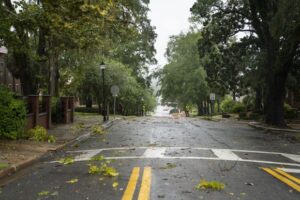
The Tallahassee community managed to escape a direct hit from a hurricane for the second year in a row. Initially starting off as a Category 3, Hurricane Idalia made landfall as a Category 4 on Wednesday, August 30 around 7:45 a.m. near Keaton Beach.
Although no severe damages and flooding occurred in Leon County, the same couldn’t be said for their neighbors to the east like Taylor County, or coastal towns on the west coast of the peninsula near Cedar Key and Steinhatchee.
Idalia was the first hurricane to hit the Apalachee Bay coastline since 1851 when weather record-keeping began. The storm forced Florida Gov. Ron DeSantis to issue evacuations for almost half the counties in the state.
With heavy rain conditions, Tallahassee experienced numerous power outages across the city. The outage hit roughly 44,000 Tallahassee residents and 24,000 or more Talquin Electric customers, according to the Tallahassee Democrat.
Mayor John Dailey also addressed the conditions of the hurricane in the Tallahassee Democrat in which he implied that the odds for Tallahassee could have been a lot worse.
“It looks like when it hit landfall it jogged a little bit east,” Dailey said. “Which spared us a little bit, which is great news for Tallahassee.”
In monitoring the status of the hurricane, both schools and universities were shut down. Leon County schools were closed Wednesday, August 30 and Thursday August 31, and classes resumed on Friday September 1.
Tallahassee universities shut down as early as noon August 30, and did not reopen until Tuesday, September 5 after Labor Day Weekend.
This was an adjustment for college students and faculty, who had just begun their first week of classes and now must reacclimate themselves and their curriculum to maintain the academic calendar.
Ranyah Mccloud, a graduating senior at Florida A&M University, was bittersweet at the thought of being able to extend her summer vacation but also having to come back to school and play catch up.
“I was happy about the extra week off,” McCloud began. “Until I realized that I now have to adjust the pace of my learning after only going to two classes on the first week.”
With no idea what to expect, residents rushed to the stores to gather the necessary essentials needed to prepare for the unknown. Candles, flashlights and canned goods were rapidly cleared from the shelves and into the carts of whoever could put their hands on them first.
For people like Nehemiah Fields, who did not have the option of leaving early from his job, the picking was very slim.
“I went to Walmart and quickly realized as I walked around that they did not have everything that I needed,” Fields said. “When I finally got what I could, I proceeded to the checkout line, which was way too long, and had to get the remainder of my items from Publix.”
Despite what seemed like an overwhelming week, citizens were still able to use this break to travel and be amongst loved ones while also continuing to prepare for what the next few weeks would look like as far as normality post hurricane.